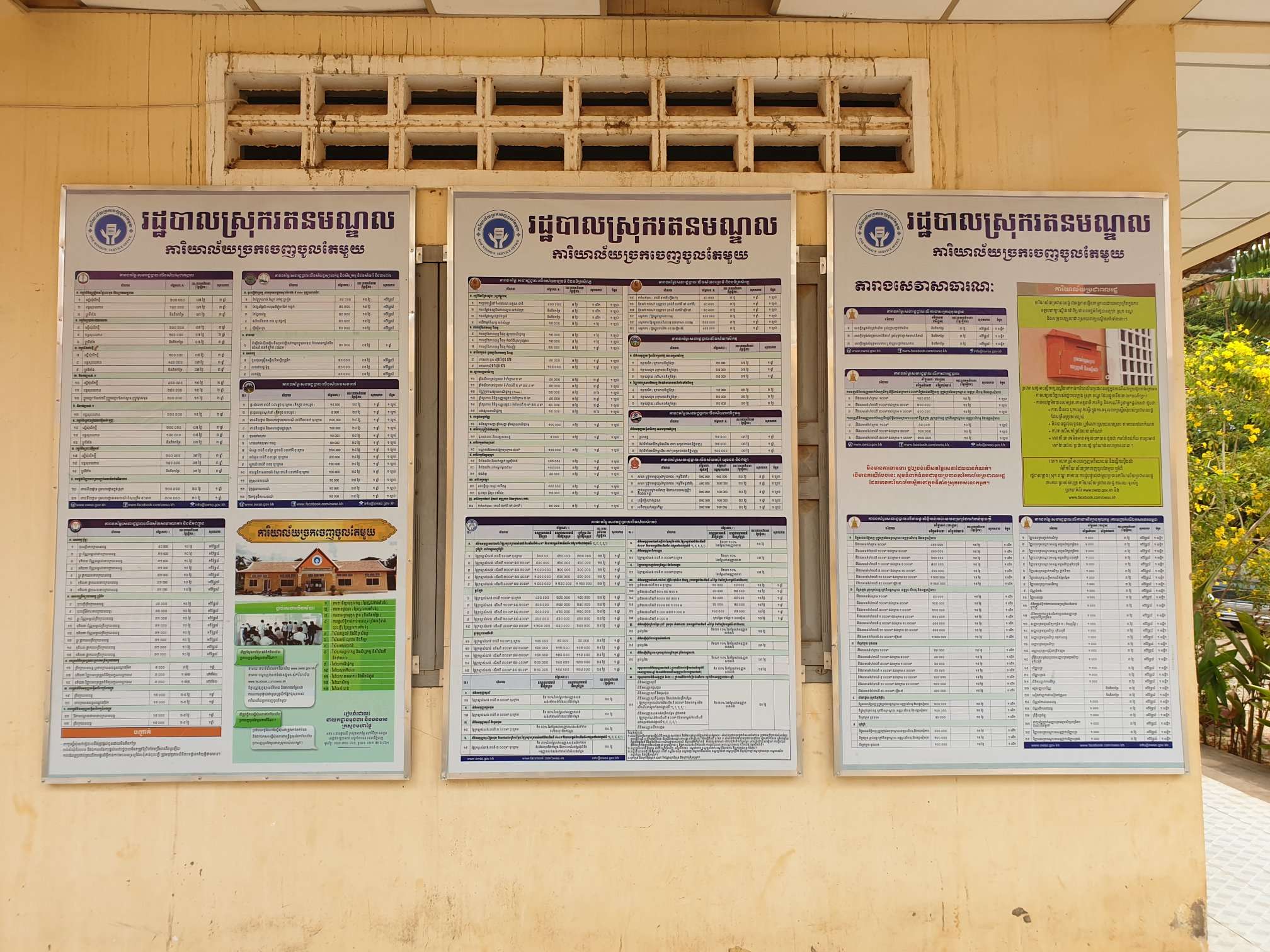
តារាងសេវាសាធារណៈនៅការិយាល័យច្រកចេញចូលតែមួយ នៅសាលាស្រុករតនមណ្ឌល ខេត្តបាត់ដំបង។ រូបភាពដោយ ក្រុមការងារអូឌីស៊ី ថតនៅថ្ងៃទី២៨ ខែកុម្ភៈ ឆ្នាំ២០២០។ ក្រោមអាជ្ញាប័ណ្ណ CC BY-SA 4.0.
សេវាកម្មរបស់រដ្ឋាភិបាល អាចត្រូវបានគេសម្លឹងឃើញថា ជាឧបករណ៍មានប្រសិទ្ធភាពប្រើឡើងសំដៅសម្រេចឱ្យបានការអភិវឌ្ឍន៍របស់ប្រទេស និងធានាឱ្យមានការបែងចែកផ្លែផ្កានៃការរីកលូតលាស់ដោយ “សមធម៌” ទៅដល់សាធារណៈជន។ នៅក្នុងប៉ុន្មានទស្សវត្សរ៍ចុងក្រោយនេះ វិស័យអប់រំ និងហេដ្ឋារចនាសម្ព័ន្ធ បានក្លាយជាវិស័យអាទិភាព សម្រាប់ការវិនិយោគសាធារណៈរបស់ប្រទេសនេះ។ ឧទារហរណ៍ នៅត្រឹមឆ្នាំ២០១៥នេះ ក្រសួងអប់រំ យុវជន និងកីឡា បានរាយការណ៍ថាមាន សាលាបឋមសិក្សាប្រមាណជា ៧,០០០ វិទ្យាល័យចំនួន ៥,៧៥០ និងគ្រឹះស្ថានឧត្តមសិក្សាប្រមាណជាជាង ១០០ នៅទូទាំងប្រទេស។1 នៅរវាងឆ្នាំ២០០៨ និងឆ្នាំ២០១២ ចំណាយរបស់ប្រទេសលើហេដ្ឋារចនាសម័ន្ធសាធារណៈ មានដូចជា ផ្លូវ ស្ពាន កំពង់ផែរ ប្រព័ន្ធធារាសាស្ត្រ និងអគ្គិសនី មានតម្លៃប្រមាណជា ២.៥ ប៊ីលានដុល្លារអាមេរិក។2
ផ្ទុយទៅវិញ វិស័យសុខាភិបាល នៅត្រូវការការកែលម្អបន្ថែមទៀត។ វិស័យនេះ បានទទួលការធ្វើកំណែទម្រង់ជាច្រើនលើក ចាប់តាំងពីទស្សវត្សរ៍ឆ្នាំ១៩៨០ មកម្លេះ។3 ទោះជាយ៉ាងណា នៅក្រោមក្របខណ្ឌនៃការទទួលបានសេវាសុខភាពសាធារណៈ គុណភាពនៃការផ្តល់សេវា និងការគ្រប់គ្រងវិស័យនេះ វិស័យសុខាភិបាល នៅត្រូវការកិច្ចខំប្រឹងប្រែង និងធនធានបន្ថែមទៀត ពីរាជរដ្ឋាភិបាល និង ភាគីពាក់ព័ន្ធផ្សេងទៀត។ យោងទៅតាម ការស្ទង់មតិប្រជាសាស្ដ្រនិងសុខភាព នៃប្រទេសកម្ពុជា (ឆ្នាំ២០១០) មានតែមនុស្ស ១ នាក់ ក្នុងចំណោម ៤នាក់ នៃប្រជាជនសរុបរបស់ប្រទេសនេះ បានប្រើប្រាស់សេវាសាធារណៈ ខណៈដែលអ្នកដទៃទៀត ត្រលប់ទៅប្រើសេវាសុខភាពឯកជន។4 បន្ថែមពីលើនេះ នៅក្នុងការសិក្សាមួយ ដែលធ្វើឡើងដោយអង្គការអាឡឺម៉ង់ GIZ កាលពីឆ្នាំ២០១០ បានឱ្យដឹងថា គុណភាពសេវាសុខាភិបាលមិនគ្រប់គ្រាន់ ការខ្វះខាតសម្ភារៈ និងអាកប្បកិរិយារបស់បុគ្គលិកវេជ្ជសាស្ត្រ គឺស្ថិតក្នុងចំណោមចន្លោះខ្វះខាតដែលត្រូវបានកំណត់រកឃើញសម្រាប់វិស័យនេះ។5
ជាយូរមកហើយ រាជរដ្ឋាភិបាល នៃប្រទេសកម្ពុជា បានសម្លឹងឃើញការផ្តល់សេវាសាធារណៈប្រកបដោយប្រសិទ្ធភាព និងប្រសិទ្ធផល ថាជាចក្ខុវិស័យស្នូលមួយក្នុងចំណោមចក្ខុវិស័យស្នូលដទៃទៀត នៃយុទ្ធសាស្ត្រចតុកោណដំណាក់កាលទី១ ដំណាក់កាលទី២ និងដំណាក់កាលទី៣។ ដើម្បីសម្រេចបានចក្ខុវិស័យនេះ ការបន្តធ្វើកំណែទម្រង់រដ្ឋបាលនៅក្នុងវិស័យសេវាសាធារណៈ គឺត្រូវការចាំបាច់។ ខណៈដែលវិមជ្ឈការ និងវិសហមជ្ឈការ អាចនាំសេវាខិតទៅជិតនឹងប្រជាជន និងកាត់បន្ថយចំណាយធ្វើជំនួញ រដ្ឋាភិបាលអ៊ីនធឺណេត (e-Government) អាចជួយបង្កើនល្បើនដំណើរការឯកសារ និងធានាពីតម្លាភាពនៃកិច្ចការដំណើការឯកសារ។
ឧទាហរណ៍ ច្រកចេញចូលតែមួយ យន្តការសម្រាប់ការផ្តល់សេវាប្រកបដោយប្រសិទ្ធភាព និងទាន់ពេល បម្រើឱ្យដល់ប្រជាពលរដ្ឋ អ្នកជំនួញ និងសហគ្រិនតូចតាច។6 វាគឺជាយន្តការមួយដែល តាមរយៈការធ្វើប្រតិភូកម្មអំណាច និងការធ្វើសេចក្តីសម្រេចិត្តពីក្រសួងសាម៊ីរបស់រាជរដ្ឋាភិបាល រដ្ឋបាលមូលដ្ឋាន អាចបំពេញសេវារដ្ឋបាលក្នុងនាមក្រសួង ដើម្បីឆ្លើយតបទៅនឹងតម្រូវការជាប្រក្រតីរបស់សាធារណជន។7 លើសពីនេះ រាល់កិច្ចការឯកសារ ដែលជាធម្មតាត្រូវធ្វើតាមបែបទរដ្ឋបាលផ្សេងគ្នារបស់ក្រសួងខុសៗគ្នា ឬមន្ទីរជុំវិញខេត្តនៃក្រសួងពាក់ព័ន្ធ អាចធ្វើឡើងនៅមួយកន្លែង ឯទីស្នាក់ការរដ្ឋបាលស្រុកឫខណ្ឌ។
កំណែទម្រង់រដ្ឋបាលគួរជាទីកត់សម្គាល់មួយផ្សេងទៀត ត្រូវបានធ្វើឡើងសម្រាប់មន្ត្រីរាជការ។8 នៅខែធ្នូ ឆ្នាំ២០១៣ ក្រសួងមុខងារសាធារណៈ ត្រូវបានបង្កើតឡើង ដើម្បមើលការខុសត្រូវ និងវាយតម្លៃលើប្រសិទ្ធភាពនៃមុខងារសារធារណៈ ធានាប្រសិទ្ធភាពនៃការគ្រប់គ្រងនិងរៀបចំផែនការមន្ត្រីរាជការ និងផ្តួចផ្តើមរៀបចំផែនការយុទ្ធសាស្ត្រសម្រាប់មន្ត្រីរាជការដែលត្រូវចូលនិវត្តន៍។9 ជាពិសេស ការលើកកម្ពស់ជីវភាពរស់នៅសមរម្យរបស់បុគ្គលិករដ្ឋ ក៏ជាផ្នែកមួយនៃកំណែទម្រង់របស់រាជរដ្ឋាភិបាលផងដែរ សំដៅបង្កើនគុណភាពសេវាសាធារណៈ។ ឧទាហរណ៍ នៅឆ្នាំ២០១៨ ប្រាក់បៀវត្សរ៍ប្រចាំខែ របស់កងកម្លាំងប្រដាប់អាវុធ និងមន្ត្រីរាជការស៊ីវិល នឹងត្រូវបានបង្កើនឡើងរហូតដល់ជាង ១លានរៀល ឬប្រហែល ២៥០ដុល្លារអាមេរិក ស្របតាមគោលនយោបាយរបស់រាជរដ្ឋាភិបាល។10
ទាក់ទងនឹងសេវាកម្មរបស់រដ្ឋាភិបាល
បច្ចុប្បន្នភាពចុងក្រោយ ថ្ងៃទី ៦ ខែមករា ឆ្នាំ២០១៦
ឯកសារយោង
- 1. បុគ្គលិកសារព័ត៌មាន. “តំណាងរាស្ត្រ និងបុគ្គលិកសិក្សាពិភាក្សាពីវិធានការណ៍កំណែទម្រង់សម្រាប់ប្រព័ន្ធអប់រំ” ឌឹ ខេមបូឌា ហឺរ៉ល ចុះថ្ងៃទី ៣១ ខែមីនា ឆ្នាំ២០១៥។ ចូលអាននៅថ្ងៃទី ២១ ខែតុលា ឆ្នាំ២០១៥។ https://opendevelopmentcambodia.net/news/cambodian-lawmakers-educators-discuss-reform-measures-for-educational-system/
- 2. ម៉ាយ គុណមករា. “ចំណាយហេដ្ឋារចនាសម្ព័ន្ធកើនឡើង.” ” ភ្នំពេញប៉ុស្តិ៍ ចុះថ្ងៃទី ២២ ខែកុម្ភៈ ឆ្នាំ២០១៣។ ចូលអាននៅថ្ងៃទី ២១ ខែតុលា ឆ្នាំ២០១៥។ http://www.phnompenhpost.com/business/infrastructure-spending-rises
- 3. លៀង សុភាព និង ឆេង កាណារ៉ាត់. “ដោះស្រាយបញ្ហាគំលាតនៅក្នុងការផ្តល់សេវាប្រព័ន្ធសុខាភិបាលនៅកម្ពុជា.” វេទិកាស្រាវជ្រាវអភិវឌ្ឍន៍. របាយការណ៍សំយោគ លេខ ០៦ (ឆ្នាំ២០១៤) ទំព័រ១-២។ ចូលអាននៅថ្ងៃទី ២៧ ខែតុលា ឆ្នាំ២០១៥។ http://www.cdri.org.kh/webdata/policybrief/drf/SynthesisReport6.pdf
- 4. ដូចខាងដើម, ទំព័រទី៣។
- 5. អង្គការ GTZ. ការថែទាំសុខភាពសម្រាប់ជនងាយរងគ្រោះនៅកម្ពុជា. រាជធានីភ្នំពេញ: GTZ, ឆ្នាំ២០១០, ទំព័រ៨។ ចូលអាននៅថ្ងៃទី ២៧ ខែតុលា ឆ្នាំ២០១៥។ http://www.mopotsyo.org/Highlight2010_Dec_2011_Feb/Cambodian%20German%20Social%20Health%20Protection%20Programme_%20Final%20report%20on%20vulnerable%20groups_%2026%20November%202010.pdf
- 6. ច្រកចេញចូលតែមួយ. “ឯកសារច្បាប់: សេចក្តីសម្រេច លេខ ១២ ស្តីពីការបង្កើតការិយាល័យច្រកចេញចូលតែមួយ និងការិយាល័យប្រជាពលរដ្ឋ”។ ចូលអាននៅថ្ងៃទី ១៥ ខែធ្នូ ឆ្នាំ២០១៥។ http://owso.gov.kh/wp-content/uploads/2011/08/Decision-of-Making-OWSO-Project.pdf
- 7. បញ្ជីរាយនាមសេវាកម្ម តម្លៃ និងពាក្យសុំ អាចរកបាននៅគេហទំព័រការិយាល័យច្រកចេញចូលតែមួ។ ការិយាល័យច្រកចេញចូលតែមួយ. “សេវាកម្ម និងតម្លៃ”។ ចូលអាននៅថ្ងៃទី ២១ ខែតុលា ឆ្នាំ២០១៥។ http://www.owso.gov.kh/?page_id=254&lang=kh
- 8. កម្ពុជាទស្សនៈថ្មី. “យុទ្ធសាស្ត្រចតុកោណដើម្បីកំណើន ការងារ សមធម៌ និងប្រសិទ្ធភាព ដំណាក់កាលទី២.”។ ចូលអាននៅថ្ងៃទី ២១ ខែតុលា ឆ្នាំ២០១៥។ http://cnv.org.kh/wp-content/uploads/2013/10/26sep13_rectangular-strategy_phaseIII.pdf
- 9. ក្រសួងមុខងារសាធារណៈ. “អំពីក្រសួង.”។ ចូលអាននៅថ្ងៃទី ២៧ ខែតុលា ឆ្នាំ២០១៥។ http://www.mcs.gov.kh/?page_id=180
- 10. វង្ស សុខហេង. “កម្ពុជាត្រូវការប្រហែលជា ៤.២ប៊ីលានដុល្លារអាមេរិកសម្រាប់ឆ្នាំ២០១៦.” ភ្នំពេញប៉ុស្តិ៍ ចុះថ្ងៃទី ២0 ខែឧសភា ឆ្នាំ២០១៥។ ចូលអាននៅថ្ងៃទី ២៦ ខែតុលា ឆ្នាំ២០១៥។ http://bit.ly/1HrHG7W

